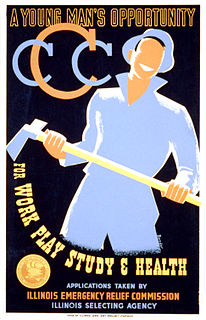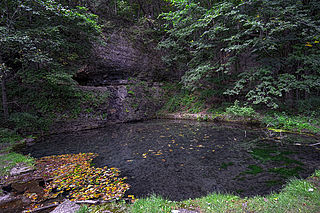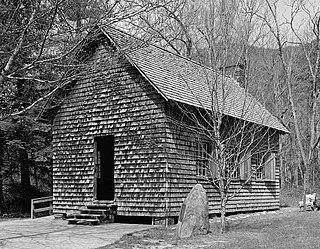
The Civilian Conservation Corps (CCC) was a voluntary public work relief program that operated from 1933 to 1942 in the United States for unemployed, unmarried men ages 18–25, it was eventually expanded to ages 17–28. Robert Fechner was the first director of this agency, succeeded by James McEntee following Fechner's death. The CCC was a major part of President Franklin D. Roosevelt's New Deal that provided manual labor jobs related to the conservation and development of natural resources in rural lands owned by federal, state, and local governments. The CCC was designed to provide jobs for young men and to relieve families who had difficulty finding jobs during the Great Depression in the United States. Maximum enrollment at any one time was 300,000. Through the course of its nine years in operation, 3 million young men participated in the CCC, which provided them with shelter, clothing, and food, together with a wage of $30 per month.

Forestry is the science and craft of creating, managing, using, conserving and repairing forests, woodlands, and associated resources for human and environmental benefits. Forestry is practiced in plantations and natural stands. The science of forestry has elements that belong to the biological, physical, social, political and managerial sciences.

Maquoketa Caves State Park is a state park of Iowa, United States, located in Jackson County. It stands northwest of the city of Maquoketa. In 1991 111 acres (45 ha) on the east side of the park were listed as a historic district on the National Register of Historic Places.

Yale School of the Environment (YSE) is a professional school of Yale University. It was founded to train foresters, and now trains environmental leaders through four 2-year degree programs and two 10-month mid-career programs. YSE strives to create new knowledge that will sustain and restore the health of the biosphere and emphasizes the possibility of creating a regenerative coexistence between humans and non-human life and the rest of the natural world. Still offering forestry instruction, the school has the oldest graduate forestry program in the United States.

Lake Keomah State Park is a state park of Iowa, USA. It is in Mahaska County. To the park's immediate east is Keomah Village and the park is approximately 4 miles (6.4 km) east of Oskaloosa.

Backbone State Park is Iowa's oldest state park, dedicated in 1919. Located in the valley of the Maquoketa River, it is approximately three miles (5 km) south of Strawberry Point in Delaware County. It is named for a narrow and steep ridge of bedrock carved by a loop of the Maquoketa River originally known as the Devil's Backbone. The initial 1,200 acres (490 ha) were donated by E.M. Carr of Lamont, Iowa. Backbone Lake Dam, a relatively low dam built by the Civilian Conservation Corps (CCC) in the 1930s, created Backbone Lake. The CCC constructed a majority of trails and buildings which make up the park.

Dolliver Memorial State Park is a state park of Iowa, US, featuring high bluffs and deep ravines on the Des Moines River. The park is located 10 miles (16 km) south of Fort Dodge and 3 miles (4.8 km) northwest of Lehigh. The park contains two listings on the National Register of Historic Places: Dolliver Memorial State Park, Entrance Area and Dolliver Memorial State Park, Picnic, Hiking & Maintenance Area .

Black Hawk State Park is a state park of Iowa, USA, in the town of Lake View. The park includes land, campgrounds, trails, game preserves, historic structures, and the waters of Black Hawk Lake. Also it is home to the Lake View Water Carnival. This event is held the third full weekend in July every year, and includes many family-friendly activities including a Water Parade. Three sections of the park were listed on the National Register of Historic Places in 1991.

Sanborn Field is an agricultural experiment field, located on the University of Missouri campus in Columbia, Missouri. Established in 1888, it was the first facility in the United States intended to measure erosion and run-off for differing crops and agricultural practices. Work at Sanborn Field was influential in the establishment of soil conservation policy in the United States. The field was designated a National Historic Landmark in 1964.

Copper Falls State Park is a 3,068-acre (1,242 ha) state park in Wisconsin. The park contains a section of the Bad River and its tributary the Tylers Forks, which flow through a gorge and drop over several waterfalls. Old Copper Culture Indians and later European settlers mined copper in the area. The state park was created in 1929 and amenities were developed by the Civilian Conservation Corps and the Works Progress Administration. In 2005 the park was listed on the National Register of Historic Places as a site with 10 contributing properties.

The Biltmore Forest School was the first school of forestry in North America. The school of "practical forestry" was founded by Carl A. Schenck in 1898 on George W. Vanderbilt's Biltmore Estate near Asheville, North Carolina. The school grounds are now part of Pisgah National Forest in Transylvania County, North Carolina.

The Great Plains Shelterbelt was a project to create windbreaks in the Great Plains states of the United States, that began in 1934. President Franklin D. Roosevelt initiated the project in response to the severe dust storms of the Dust Bowl, which resulted in significant soil erosion and drought. The United States Forest Service believed that planting trees on the perimeters of farms would reduce wind velocity and lessen evaporation of moisture from the soil. By 1942, 220 million trees had been planted, stretching out 18,600 miles (29,900 km) in a 100-mile-wide zone from Canada to the Brazos River. Even as of 2007, "the federal response to the Dust Bowl, including the Prairie States Forestry Project which planted the Great Plains Shelterbelt and creation of the Soil Erosion Service, represents the largest and most-focused effort of the [U.S.] government to address an environmental problem".

Lake Ahquabi State Park is a state park of Iowa, US, featuring a 115-acre (47 ha) reservoir. Ahquabi means "resting place" in the Fox language. The park is 6 miles (9.7 km) south of Indianola and 22 miles (35 km) south of Des Moines. Three sections of the park were listed on the National Register of Historic Places in 1991.
The Central Design Office, Ames was a design office at Iowa State, in Ames, Iowa that designed public works, many built under the Civilian Conservation Corps program. It designed many that are listed on the U.S. National Register of Historic Places.

Pilot Knob State Park is located southeast of Forest City, Iowa, United States. Founded in 1923, it is one of the oldest state parks in Iowa. Between 1990 and 1995 one area was named nationally recognized historic district and five structures were individually listed on the National Register of Historic Places.

Lacey-Keosauqua State Park is located southwest of Keosauqua, Iowa, United States. Located along the Des Moines River in Van Buren County, it was dedicated in 1921. It is the largest state park in size in Iowa. In 1990 three areas were named nationally recognized historic districts and listed on the National Register of Historic Places.

The Jones Creek Watershed Historic District is a nationally recognized historic district located southwest of Moorhead, Iowa, United States. It was listed on the National Register of Historic Places in 1991. At the time of its nomination it contained 19 resources, which included eight contributing structures, nine non-contributing buildings, and two non-contributing structures. The historic district is made up of eight gully control dams erected by the Civilian Conservation Corps (CCC) Camp DPE-79, working for the Soil Conservation Service (SCS). They were built between 1937 and 1941. The project was completed by crews from the conscientious objector camp in Denison in late 1941 and 1942.

The Civilian Conservation Corps-Prisoner of War Recreation Hall is a historic building located in Eldora, Iowa, United States. Known as Camp Flying Goose, the Civilian Conservation Corps' (CCC) Company 1755 made Eldora their home base in 1933. They constructed this building that year for their use as a barracks while they worked on projects in the area, which included building Upper Pine Lake in Pine Lake State Park. CCC Company 1752, the Erosioners, replaced them two years later, and they built many of the facilities in the park. With the start of World War II, the CCC left the camp. The National Youth Association used the camp from 1940 to 1942.

Bandshell Park, also known as City Park and Music Pavilion, is located in Ames, Iowa, United States. It is a nationally recognized historic district that was listed on the National Register of Historic Places in 1999. At the time of its nomination it consisted of six resources, which included one contributing building, one contributing site, two contributing structures, one contributing object, and one non-contributing object. The park, located to the east of the central business district, was gift to the city in 1884 from the C&NW Land Company. The full city block was the first park established in Ames.

The Idaho State Forester's Building, also known as The Cabin, in Boise, Idaho, is a 1 1⁄2-story log cabin designed by Boise Payette Lumber Company architect Hans C. Hulbe and constructed in 1940 by round-log artists John Heillila and Gust Lapinoja. Logs for the cabin are peeled Engelmann spruce with full dovetail notch and oakum chinking. Inside paneling on office walls includes yellow pine, white pine, and western red cedar, and all of the wood came from Idaho forests and was donated by lumber companies with business interests in Idaho. The building was added to the National Register of Historic Places in 1997.






















